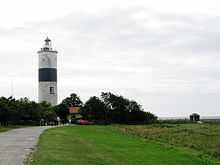Långe Jan
 Långe Jan | |
| Location | Ottenby, Öland's south cape, Sweden |
|---|---|
| Coordinates | 56°12′N 16°24′E / 56.200°N 16.400°ECoordinates: 56°12′N 16°24′E / 56.200°N 16.400°E |
| Year first constructed | 1785 |
| Year first lit | 1785 |
| Automated | 1948 |
| Deactivated | Active |
| Foundation | Limestone |
| Construction | Limestone |
| Tower shape | Cylindrical tower, conical bottom |
| Markings / pattern | White tower with black band |
| Height | 41.6 m (135 ft.) |
| Focal height | 41 m |
| Original lens | Open fire |
| Current lens | Third order Fresnel, 1907 |
| Range | 18 nautical miles (33 km; 21 mi) |
| Characteristic | Fl. (2) 30 s |
| Admiralty number | C7280 |
| NGA number | 7720 |
| ARLHS number | SWE-041; SV-5528 |
Långe Jan ("Tall John") is a Swedish lighthouse located at the south cape of Öland in the Baltic Sea, Sweden's second largest island.[1] It is one of Sweden's most famous lighthouses along with Kullen, Vinga and Landsort, and also the tallest lighthouse in Sweden.
The lighthouse was built in 1785,[1] probably by Russian prisoners of war. The tower was built of stone from an old chapel. Originally the light was an open fire, and the tower was unpainted. It was painted white in 1845, and the same year the tower's lantern was installed, to house a colza oil lamp. A couple of years later a black band was added to the tower.
The lighthouse remains in use and is remote-controlled by the Swedish Maritime Administration in Norrköping. During the summer season it is possible to climb the tower, for a small fee.
The buildings surrounding the tower form Ottenby birding station.
See also
- Långe Erik ("Tall Erik"), the lighthouse at the north cape of Öland.
References
- ↑ 1.0 1.1 "Långe Jan". Nationalencyklopedin (in Swedish). Retrieved 1 September 2010.
- Rowlett, Russ. "Lighthouses of Sweden: Kalmar". The Lighthouse Directory. University of North Carolina at Chapel Hill. Retrieved 8 September 2008.